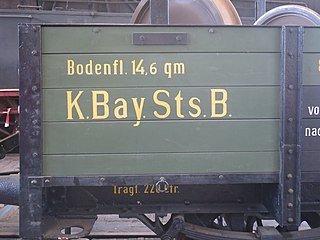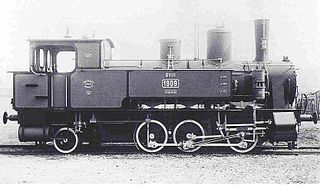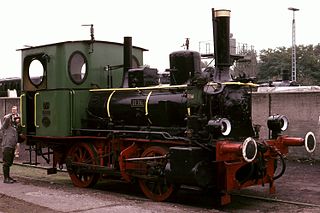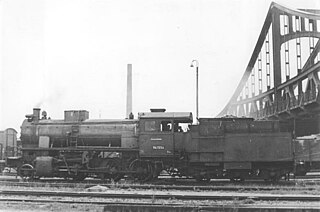
The Royal Bavarian State Railways was the state railway company for the Kingdom of Bavaria. It was founded in 1844. The organisation grew into the second largest of the German state railways with a railway network of 8,526 kilometres by the end of the First World War.

The Class S 3/6 steam locomotives of the Royal Bavarian State Railways were express train locomotives with a 4-6-2 Pacific or 2'C1' wheel arrangement.
The steam engines of Class G 4/5 H operated by the Royal Bavarian State Railways were the most powerful of the German, 2-8-0, freight locomotives.

The Bavarian Class D VIII were saturated steam locomotives with the Royal Bavarian State Railways.

The Bavarian Class Gt 2×4/4 engine of the Royal Bavarian State Railways, was a heavy goods train tank locomotive of the Mallet type. It was later designated the DRG Class 96 by the DRG, DB and DR.

The Bavarian Class D VI were German, 0-4-0, steam locomotives of the Royal Bavarian State Railways. They were light, twin-coupled, saturated steam, tank engines. Maffei supplied the first 30 locomotives from 1880 to 1883, and Krauss delivered a further 23 up to 1894.

The Bavarian Class R 3/3 of the Royal Bavarian State Railways was an 0-6-0T intended for goods trains. Of the engines delivered before World War I, one went to the Polish PKP, the other 17 were included by the Deutsche Reichsbahn as Class 89.7 in their numbering plan. The 90 units of the second series that were supplied from 1921 onwards all went into the Reichsbahn, and were designated as Class 89.8. 86 examples went into the Deutsche Bundesbahn after the Second World War and the last one was not taken out of service until 1960.
The D IX steam locomotive was manufactured by the firm of Maffei between 1888 and 1899 for the Royal Bavarian State Railways. They were used on the route from Reichenhall via Freilassing to Salzburg. After one engine had been successfully employed on the route to Berchtesgaden, the vehicles were also deployed on the suburban lines of Augsburg, Munich and Nuremberg.

The Bavarian G 5/5 goods train, steam locomotives were intended for steep stretches of line belonging to the Royal Bavarian State Railways network in northern Bavaria. The extremely sharp rise in the levels of traffic on these lines in the years leading up to the First World War meant that the eight-coupled Bavarian E I and G 4/5 N classes previously employed there were increasingly unable to cope.

The Class G 3/4 H was a steam locomotive of the Royal Bavarian State Railways built between 1919 and 1923.

The goods train locomotives of Class C VI were German steam engines built between 1899 and 1905 for the Royal Bavarian State Railways. It had great similarity to the Prussian G 5.4, but had a higher boiler overpressure and better riding qualities. In all the Bavarian state railways procured 83 engines of this type over that period. More machines with slight modifications were acquired between 1907 and 1909. These 37 engines were given the designation G 3/4 N. The Deutsche Reichsbahn inherited 64 Class C VI and 32 Class G 3/4 N engines. These were given operating numbers 54 1301–1364 and 54 1401–1432. The Class C VII locomotives remained in service until 1931, their Class G 3/4 N sister locomotives until 1935.

The C IV was a steam locomotive, built for goods train duties, that was manufactured between 1884 and 1897 for the Royal Bavarian State Railways.
The 36 locomotives of Class P 3/5 N of the Royal Bavarian State Railways were built between 1905 and 1907 by Maffei. The P 3/5 N evolved from the S 3/5 express train locomotive and had likewise a four-cylinder compound configuration. Compared with the S 3/5 the P 3/5 N had a smaller boiler but the same size cylinders. The P 3/5 N could haul a 350-ton train at 80 km/h on the level.
The Class S 3/5 engines of the Royal Bavarian State Railways were express train steam locomotives with a 4-6-0 wheel arrangement.
The Class C V of the Royal Bavarian State Railways was one of the first European express train locomotives with a 4-6-0 wheel arrangement.
The Class S 2/5 express locomotives of the Royal Bavarian State Railways were the first steam engines in Germany to be built with full-length bar frames. The prototypes for this type of frame were the two locomotives imported in 1900 from Baldwin Locomotive Works in the US, that had been similarly classified as the S 2/5.
The Bavarian Class E I steam locomotives operated by the Royal Bavarian State Railways encompassed four different variants of saturated steam, goods train locomotive with a 2-8-0 wheel arrangement.

The Prussian G 12 is a 1'E 2-10-0 goods train locomotive built for the Prussian state railways.

The Prussian G 10 was a German goods train, steam locomotive, whose design was based on a combination of the running and valve gear from the Prussian T 16 and the boiler from the Prussian P 8. In developing the G 10, however, the T 16 running gear with side play on the first and fifth axles was modified. The T 16 was also subsequently built with this modified configuration and called the Prussian T 16.1. The G 10 was intended for heavy goods train duties on main lines, but as a result of its low axle load it could be employed more flexibly than its equally powerful cousin, the Prussian G 8.1. The G 10 was occasionally even used in passenger train service.

The Prussian G 7.3 was a class of 2-8-0 locomotives of the Prussian state railways. The third class of the G 7 series, they were intended to power heavy goods trains on steep inclines, on which the permissible axle load was not yet that high. This affected for example, the Paderborn–Holzminden and Betzdorf–Siegen routes.












